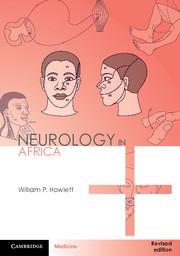Book contents
- Frontmatter
- Dedication
- Contents
- PREFACE
- Acknowledgments
- Part II Neurological Disorders
- 3 Public Health
- 4 Epilepsy
- 5 Stroke
- 6 Neurological Infections
- 7 Protozoal Andhelminthic Infections
- 8 Neurological Illness in HIV Disease
- 9 Coma and Transient Loss of Consciousness
- 10 Paraplegia Non Traumatic
- 11 Disorders of Peripheral Nerves
- 12 Cranial Nerve Disorders
- 13 Myopathies and Myasthenia Gravis
- 14 Movement Disorders and Motor Neurone Disease
- 15 Headache and Facial Pain
- 16 Intracranial Tumours
- 17 Dementia
- 18 Inherited Neurological Disorders
- 19 Head and Spinal Injury
- 20 Care in Neurology
- INDEX
- ABBREVIATIONS
- USEFUL WEBSITES
4 - Epilepsy
from Part II - Neurological Disorders
- Frontmatter
- Dedication
- Contents
- PREFACE
- Acknowledgments
- Part II Neurological Disorders
- 3 Public Health
- 4 Epilepsy
- 5 Stroke
- 6 Neurological Infections
- 7 Protozoal Andhelminthic Infections
- 8 Neurological Illness in HIV Disease
- 9 Coma and Transient Loss of Consciousness
- 10 Paraplegia Non Traumatic
- 11 Disorders of Peripheral Nerves
- 12 Cranial Nerve Disorders
- 13 Myopathies and Myasthenia Gravis
- 14 Movement Disorders and Motor Neurone Disease
- 15 Headache and Facial Pain
- 16 Intracranial Tumours
- 17 Dementia
- 18 Inherited Neurological Disorders
- 19 Head and Spinal Injury
- 20 Care in Neurology
- INDEX
- ABBREVIATIONS
- USEFUL WEBSITES
Summary
Introduction
Epilepsy is a predisposition to recurrent unprovoked seizures. Seizures are caused by attacks of sudden, excessive, abnormal electrical discharges arising mainly from the neurones in the cortex of the brain. The site, spread and pattern of electrical discharges determine the clinical features of epilepsy. The seizures may range from a brief awareness of sensation lasting only seconds to a sudden loss of consciousness associated with involuntary stiffening and jerking body movements. The latter is termed generalized tonic-clonic epilepsy and historically was called grand mal. Epilepsy is the most common community based major neurological disorder and the individual case history and description of the seizure are crucial to the diagnosis of epilepsy. This chapter outlines the main epilepsy syndromes, their classification, causes, clinical presentation diagnosis and management. The student should aim for an overall understanding of epilepsy and in particular its burden, diagnosis, management and treatment.
EPILEPSY SYNDROMES
Epilepsy is classified according to cause and clinical seizure type. Idiopathic epilepsy (60-70%) occurs where no known cause is found or suspected and many of these are most likely genetic in origin. Symptomatic epilepsy (30-40%) occurs when there is an underlying structural abnormality in the cerebral cortex such as a scar or tumour or another condition predisposing to seizures. Seizures in epilepsy may be classified according to their clinical presentation and their site of electrical origin in the brain (Table 4.1). If seizures arise focally from one site within the brain these are termed as the partial onset seizures. These can present with motor, sensory, autonomic and psychological symptoms. If the electrical discharge remains focal and consciousness is fully retained, these are classified as simple partial seizures. If the electric discharge arises focally and consciousness is altered, these are classified as complex partial seizures. If the electrical discharge arises focally and spreads to involve the rest of the entire cerebral cortex, this results in a generalized tonic-clonic seizure. These are classified as secondary generalized tonic-clonic seizures (grand mal) and are the most common type of seizure disorder (70%). Seizures may also arise from electrical discharges deep within the brain spreading equally rapidly to all parts of the cortex at the same time. These are termed as generalized onset seizures (30%).
- Type
- Chapter
- Information
- Neurology in AfricaClinical Skills and Neurological Disorders, pp. 75 - 96Publisher: Cambridge University PressPrint publication year: 2015



